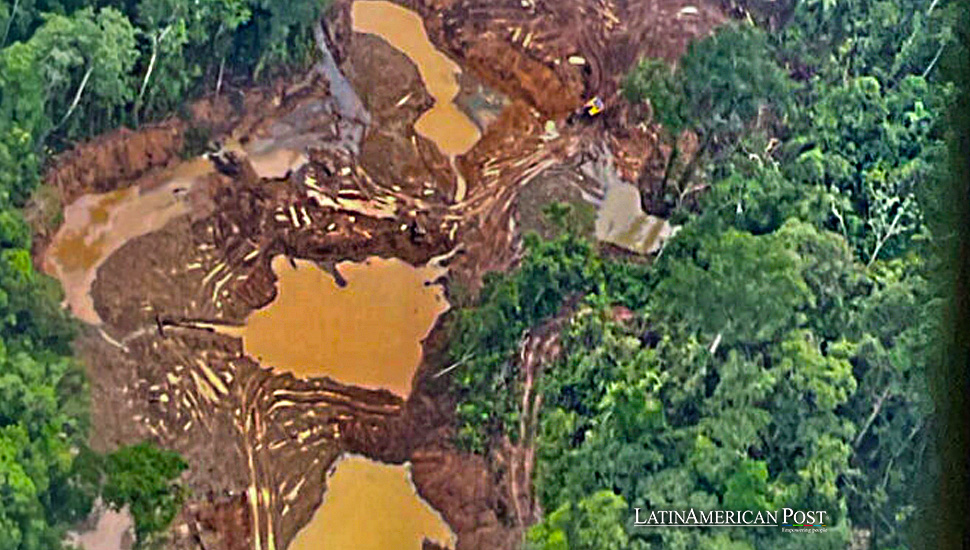Illegal Mining Ravages Ecuador’s Amazon as Evidenced in a Dire Increase in Deforestation

In 2023, illegal gold mining activities devastated 784 hectares of jungle forests along the Punino River in Ecuador’s Amazon, marking a stark escalation in environmental destruction within this vital ecosystem.
Crisis Unfolding in Ecuador’s Amazon
Ecuador’s Amazon’s lush, biodiverse expanses have long been a beacon of natural beauty and ecological importance. Yet, beneath the canopy, a crisis has been unfolding that threatens the very fabric of this critical environment. The Punino River area, nestled between the Napo and Orellana provinces, has become a focal point of devastation due to illegal gold mining activities. In 2023 alone, this illicit practice has led to the destruction of 784 hectares of jungle, an alarming increase underscoring the urgent need for action.
The Andean Amazon Monitoring Project (MAAP), an initiative dedicated to tracking deforestation in the Amazon basin through satellite imagery analysis, has revealed these startling figures. The MAAP’s latest report highlights that the area impacted by illegal mining in the Punino River zone surged from 267 hectares to over 1,000 hectares in just one year, a staggering 261% increase. Of this, 904 hectares—over 90% of the total affected area—are located outside legally authorized mining zones, unequivocally pointing to the illegal nature of these operations.
Encroachment on Protected Areas: A Dire Warning
This surge in illegal mining activity encroaches upon the newly established El Chaco Municipal Conservation Area adjacent to the Sumaco Napo-Galeras National Park. This encroachment signals a direct threat to protected areas and the broader ecosystem that plays a critical role in regional and global environmental health.
The relentless advance of illegal mining persists despite military efforts to curb these activities. Operations last year, including a notable one in September, saw the localization and dismantling of makeshift miner camps and the destruction of mining machinery. Yet, these efforts have not stemmed the tide of deforestation, indicating a deep-rooted challenge that requires a multifaceted approach.
The report by MAAP, a collaborative effort between Fundación EcoCiencia and Amazon Conservation, supported by the Norwegian Agency for Development Cooperation (Norad), is a part of a series focusing on the Ecuadorian Amazon. This partnership underscores the international concern and the collaborative effort required to combat the issue of illegal mining and its devastating environmental impacts.
Illegal mining in the Amazon is not a new phenomenon but part of a historical continuum that has seen various forms of natural resource extraction threaten the region’s ecological balance. Gold mining, in particular, has a long history in South America, dating back to pre-Colombian times and expanding significantly during the colonial period. In modern times, the global price of gold has spurred a new gold rush, leading to increased illegal mining activities across the Amazon basin. These operations are not only environmentally destructive but also bring a host of social problems, including labor exploitation and conflicts with indigenous communities.
Profound Environmental Consequences: Beyond Immediate Operations
The environmental consequences of illegal mining are profound. Removing vegetation, diversifying river courses, and using toxic substances such as mercury in gold extraction processes contribute to habitat destruction, water contamination, and a decrease in biodiversity. These effects are not confined to the immediate area of operation but have far-reaching implications for the Amazon’s ecological functions, including carbon storage, water cycling, and the maintenance of its incredible biodiversity.
Addressing the challenge of illegal mining requires a comprehensive strategy encompassing strict enforcement of environmental laws, promoting sustainable economic alternatives for local communities, and international cooperation to reduce the demand for illegally mined gold. Additionally, empowering indigenous communities and local stakeholders to participate in conservation efforts can provide critical on-the-ground insights and sustainable management practices that respect the ecological and cultural integrity of the Amazon.
Also read: Major Shift in Global Trade as Mexico Surpasses China as Top U.S. Import Source
The situation in Ecuador’s Amazon, particularly along the Punino River, is a stark reminder of the ongoing battle between conservation efforts and environmental degradation forces. The dramatic increase in illegal mining and its consequential deforestation in 2023 is a clarion call for renewed commitment and action from the Ecuadorian government and the international community. As the world grapples with the overarching challenges of climate change and biodiversity loss, the fate of the Amazon and its protection against illegal mining activities remains a crucial piece of the puzzle in safeguarding our planet’s environmental future.




